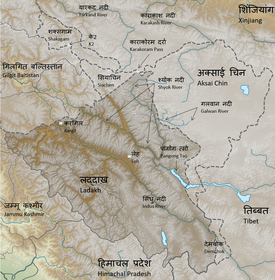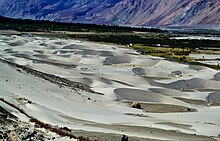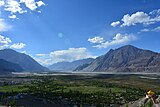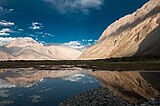Nubra
This articleneeds additional citations forverification.(May 2016) |
Nubra | |
|---|---|
region | |
 Nubra Valley withDiskit Gompaand town immediately below andHunderin the distance | |
| Coordinates:34°36′N77°42′E/ 34.6°N 77.7°E | |
| Country | |
| Union Territory | Ladakh |
| District | Leh |
| Time zone | UTC+5:30(IST) |
Nubra,also calledDumra,is a historical region ofLadakh,India[1]that is currently administered as asubdivisionand atehsilin theNubra district.Its inhabited areas form a tri-armed valley cut by theNubraandShyokrivers. Its Tibetan nameDumrameans "valley of flowers".[2]Demands have been raised andBJPhas hinted at creation of Nubra as a new district.[3]Diskit,the headquarters of Nubra, is 120 km north ofLeh,the capital of Ladakh.
TheShyok Rivermeets theNubra River(or Siachan River) to form a large valley that separates theLadakhandKarakoramRanges. The Shyok river is a tributary of the Indus river. The average altitude of the valley is more than 10,000 feet (3,000 m) above the sea level. The most common way to access this valley is to travel over theKhardung Lapass from Leh.
Foreign nationals are required to get aProtected area permitto visit Nubra. Since 1 April 2017 Indian citizens are also required to get anInner Line Permitto visit it.[4][unreliable source?]
Name
[edit]Nubra (Tibetan:ནུབ་ར,Wylie:nub ra,THL:nup ra) means "western" in Ladakhi, thus referring to the "western valley", perhaps distinguishing it from the thinly-populated eastern Shyok river valley. The traditional name of the region is Dumra (Tibetan:ལྡུམ་ར,Wylie:ldum ra,THL:dum ra), meaning "valley of flowers".[2]
Geography
[edit]
Alexander Cunninghamlisted Nubra as one of the five natural and historical divisions of Ladakh.[5]Nubra occupies the northeastern portion of Ladakh, borderingBaltistanandChinese Turkestanin the north, and theAksai Chinplateauand Tibet in the east. In Cunningham's conception, Nubra includes all the region drained by theNubraandShyokrivers. it is 128 miles long and 72 miles wide, making up an area of 9,200 square miles. It extends south till thePangong Lake.[6]
In modern nomenclature, the Nubra region is divided into "Diskit Nubra"in the north and the"Darbuk region"in the south, both of which are regarded as tehsils and subdivisions of theLeh district.[7]The Diskit Nubra region includes theTurtukblock populated byBalti people,which became a part of Indian-administered Kashmir after theIndo-Pakistani War of 1971,and the unpopulatedSiachen Glacierregion.[8]
The populated part of Nubra is often described as a "tri-armed valley",[9] the three arms being:[10]
- the Nubra River Valley (divided into three sections calledYarma,TśurkaandFarka),[a]
- Gyen,the upper Shyok valley from its southern bend till the confluence with the Nubra River, and
- Shama,the lower Shyok valley from the confluence till theChorbatarea.[10]
The eastern Shyok valley is mostly unpopulated, even though it has numerous camping sites that have been used by trade caravans.Murgois a village on the tributary called Murgo Nala.
Topography
[edit]
Like the rest of theTibetan Plateau,Nubra is a high altitudecold desertwith rare precipitation and scant vegetation except along river beds. The villages are irrigated and fertile, producing wheat, barley, peas, mustard and a variety of fruits and nuts, including blood apples, walnuts, apricots and even a few almond trees. Most of Nubra is inhabited by Nubra dialect or Nubra Skat speakers. The majority are Buddhists. In the western or lowest altitude end of Nubra near the Line of Control i.e. the Indo-Pak border, along theShyok River,the inhabitants ofTurtukareBaltiofGilgit-Baltistan,who speak Balti, and areShiaandSufia NurbakhshiaMuslims.
Siachen Glacierlies to the north of the valley. TheSasser Passand the famousKarakoram Passlie to the northwest of the valley and connect Nubra withUyghur(Mandarin:Xinjiang). Previously much trade passed through the area towards western China'sXinjiangand Central Asia. The people ofBaltistanalso used the Nubra valley for passage to Tibet.[11]
Places
[edit]Diskittown in the valley have become the congregation centre for people of the region. Diskit is the headquarters of Nubra and thus has lot of government offices with basic facilities. It is also connected by road with Leh.
Along the Nubra or Siachan River lie the villages of Sumur, Kyagar (called Tiger Village by the Indian Army),Tirith,Panamik,Turtukand many others.
Travel routes
[edit]
The main road access to Nubra is overKhardung Lawhich is open throughout the year. The highest elevation of Khardung La is 5,359 m (17,582 ft), its status as the highest motorable road in the world is no longer accepted by most authorities.[12]An alternative route, opened in 2008, crosses theWari LafromSakti,to the east of Khardung La, connecting to the main Nubra road system viaAghamandKhalsaralong theShyok River.There are also trekkable passes over the Ladakh Range from the Indus Valley at various points. Routes from Nubra toBaltistanandYarkand,though historically important, have been closed since 1947 and 1950 respectively.
Tourism
[edit]

The Nubra valley was open for tourists up toHunder(the land of sand dunes) until 2010. The region beyond Hunder gives way to a greener region of Ladakh because of its lower altitude. The village ofTurtukwhich was unseen by tourists till 2010 is a virgin destination for people who seek peace and an interaction with a tribal community of Ladakh. The localBalti peoplefollow their age old customs in their lifestyle and speak a language which oral and not yet written. For tourists Turtuk offers serene camping sites with environment friendly infrastructure.
Panamikis noted for its hot springs. Between Hundar and Diskit lie seven kilometres of sand dunes, and (two-humped)Bactrian camelsgraze in the neighbouring "forests" ofseabuckthorn.Non-locals are not allowed below Hundar village into the Balti area, as it is a border area.
Monasteries
[edit]
The 32-metreMaitreyaBuddha statue is the landmark of Nubra and is maintained by theDiskit Monastery.On the Shyok River, the main village, Diskit, is home to the dramatically positioned Diskit Monastery which was built in 14th century. Hundar was the capital of the erstwhile Nubra kingdom in the 17th century, and is home to the Chamba Gompa.
Samstanling Monastery is between Kyagar and Sumoor villages. Across the Nubra or Siachan River at Panamik, is the isolated Ensa Gompa.
Yarma Gompa, betweenSaserandSiachen Base Camp,is one of the large monastery belonging to theDrukpa Kagyulineage and it manages the following village gompas, Tong-sted, Nyung-sted, Dungsa, Khemi, Tsang-lung-ka, Sarsoma, Aarunuk, Ayi, Kovet, Tangsa & Murgo. The senior to lower hierarchy of gompa administration is Lopon, Gye-nyen, Geylong, Gye-tsul, and cun-zung.[13]
Flora and fauna
[edit]The valley is famous for its forest ofHippophaeshrub, popularly known as Leh Berry. It is within this shrub forest that one can spot thewhite-browed tit-warbler.One can also spot theTibetan lark,Hume's short-toed lark,andHume's whitethroat.The various water birds likeruddy shelduck,garganey,northern pintail,andmallardcan be observed on several small water bodies scattered along the route. Besides these,waderslikeblack-tailed godwit,common sandpiper,common greenshank,common redshank,green sandpiper,andruffcan be spotted in Nubra.[14]
Education
[edit]The valley has been secluded as has been most of the exterior parts of Ladakh. Almost all of the region has been facing problems to get good quality education. There have been initiatives in the past by the government but extreme weather conditions and vicinity to the borders have been a major hurdle in implementing a solid education base. There is also migration of the population that gets exposed to the big cities of India and hence the people do not get benefitted out of their local learned population. There are very few Non-Government organizations active in Nubra region.
In popular culture
[edit]Nubra valley was appeared, mentioned in Hollywood movieMission Impossible: FalloutofTom Cruise.In the film's climax Ethan Hunt (Cruise) stop Walker (Henry Cavill) from detonatingPlutonium bombat the base ofSiachen glacier.However filming of the scene was done in New Zealand due to India government denied filming.[15]
Gallery
[edit]-
Tourists riding camels in the sand dunes
-
Nubra valley sandunes
-
Local map with North towards down
-
View from Diskit gompa on Nubra Valley
-
Seabuckthorn berries, Nubra valley, Ladakh
-
Bactrian camels
-
Nubra Valley
-
This is enroute town calledHunderin Nubra.
-
Nubra Valley withDiskit Gompaand town immediately below andHunderin the distance
-
Hunder, Nubra Valley
-
Tent Resort in Nubra Valley
See also
[edit]- Ladakh
- Khardung La
- Siachen Glacier
- Thoise
- Chalunka
- Project HIMANK,road builders in the valley and creators of curious sign boards
- Disket
Notes
[edit]References
[edit]- ^ Shakabpa, Oe Hundred Thousand Moons (2009),pp. 583–584:"The Tibetan soldiers pursued the remaining troops as far as a place called Dumra,[10: These days, Dumra is called Nupra] just one day’s journey from Leh, where the Tibetan army pitched their camp."
- ^abKapadia, Harish (1999).Across Peaks & Passes in Ladakh, Zanskar & East Karakoram.Indus Publishing. p. 230.ISBN978-81-7387-100-9.
- ^3,000 Demonstrate for Separate District in Sub-Zero Temperatures at Kargil,The Wire, 06/FEB/2020.
- ^People, Attractions & Transportation in Nubra Valley,The Off: Leh Ladakh XP (Jai Kishan), 17 March 2021.
- ^ Cunningham, Ladak (1854),p. 18: "The natural divisions of the country are: 1st,Nubraon the Shayok; 2nd,Ladak Proper,on the Indus; 3rd,Zanskar,on the Zanskar river; 4th,Rukchu [Rupshu],around the lakes of Tshomo Riri [Tso Moriri] and Tsho-Kar; 5th,Purik, Suru, and Dras,on the different branches of the Dras river; 6th,Spiti,on the Spiti river: and 7th,Lahul,on the Chandra and Bhaga, or head-waters of the Chenab. These also are the actual divisions of the country, for the natural boundaries of a mountainous district generally remain unaltered, in spite of the changes wrought by war and religion. Ladak is divided politically between Maharaja Gulab Sing and the East-India Company. To the former belong all the northern districts, to the latter only the two southern districts of Lahul and Spiti. "
- ^Cunningham, Ladak (1854),p. 21.
- ^Tehsil,Leh district administration, retrieved 15 November 2020.
- ^ Muhammad Raafi,Interview of Delan Namgial,Kashmiri Life, 17 January 2017.
- ^ Sumedha Das,Paradise on Earth,The Statesman, 24 November 2019.
- ^abVohra, Mythic Lore from Nubra Valley (1990),pp. 225–226.
- ^Senge H. Sering, “Reclaiming Nubra” – Locals Shunning Pakistani InfluencesArchived8 July 2016 at theWayback Machine,Institute for Defence Studies and Analyses, Delhi, 17 August 2009.
- ^"Nubra Valley - World's Finest Wool".www.worlds-finest-wool.com.Retrieved10 January2022.
- ^Prem Singh Jina, 2009,Cultural Heritage of Ladakh Himalaya,p 114.
- ^Khan, Asif (2016)."Ladakh: The Land Beyond".Buceros.21(3): 6–15.
- ^"Tom Cruise's MI..."Hindustan Times.
Bibliography
[edit]- Cunningham, Alexander (1854),Ladak: Physical, Statistical, Historical,London: Wm. H. Allen and Co – via archive.org
- Francke, Rev. A. H.(1907),A History of Western Tibet,S. W. Partridge & Co – via archive.org
- Longstaff, T. G. (June 1910),"Glacier Exploration in the Eastern Karakoram",The Geographical Journal,35(6), The Royal Geographical Society: 622–653,doi:10.2307/1777235,JSTOR1777235
- Shakabpa, Tsepon Wangchuk Deden (2009),One Hundred Thousand Moons: An Advanced Political History of Tibet,BRILL,ISBN978-90-04-17732-1
- Shakspo, Nawang Tsering (1999), "The Foremost Teachers of the Kings of Ladakh", in Martijn van Beek; Kristoffer Brix Bertelsen; Poul Pedersen (eds.),Recent Research on Ladakh 8,Aarhus University Press, pp. 284–,ISBN978-87-7288-791-3
- Thomson, Thomas (1852),Western Himalaya and Tibet: A Narrative of a Journey Through the Mountains of Northern India, During the Years 1847-8,Reeve and Company – via archive.org
- Vohra, Rohit (1990), "Mythic Lore and Historical Documents from Nubra Valley in Ladakh",Acta Orientalia Academiae Scientiarum Hungaricae,44(1/2), Akadémiai Kiadó: 225–239,JSTOR23658122














